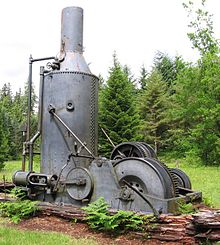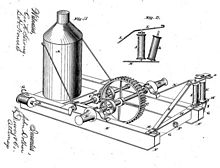Steam donkey
This article includes a list of generalreferences,butit lacks sufficient correspondinginline citations.(September 2019) |

Asteam donkeyordonkey engineis asteam-poweredwinchonce widely used inlogging,mining,maritime,and other industrial applications.
Steam powered donkeys were commonly found on large metal-hulled multi-masted cargo vessels in the later decades of theAge of Sailon through theAge of Steam,particularly heavily sailedskeleton-crewedwindjammers.
A donkey used in forestry, also known as alogging engine,was often attached to ayarderfor hauling logs from where trees were felled to a central processing area. The operator of a donkey was known as adonkeyman.
Name[edit]
Steam donkeys acquired their name from their origin in sailing ships, where the "donkey" engine was typically a small secondary engine used to load and unload cargo and raise the larger sails with small crews, or to power pumps. They were classified by their cylinder type – simplex (single-acting cylinder) or duplex (acompound engine); by their connection to the winches (or "drums" ) – triple-drum, double-drum, etc.; and by their different uses.
A good deal of the cable-logging terminology derived from 19th-century merchant sailing, as much of the early technology originated in that industry. Common logging terms include high-lead yarder, ground-lead yarder, loader, snubber, and incline hoist.
History[edit]
In logging[edit]

John Dolbeer,a founding partner of the Dolbeer and Carson Lumber Company inEureka, California,invented the logging engine in that city[1]in August 1881. The patent(number: 256553)was issued April 18, 1882. On Dolbeer's first model, a 46-metre (150 ft), 110-millimetre (4.5 in) manila rope was wrapped several times around a gypsy head (vertically mounted spool) and attached at the other end to a log.[2][3]
The invention of the steam donkey increased lumber production by enabling the transport of trees that would previously have been left behind because they were too large to move. They also enabled logging in hot or cold weather, which was not previously possible with the use of animal power.[4]
Later, the invention of theinternal-combustionengine led to the development of the diesel-poweredtractor crawler,which eventually made the steam donkey obsolete. Though some have been preserved in museums, very few are in operating order. A great number still sit abandoned in the forests.
Design[edit]
A logging donkey consists of asteam boilerandsteam engine,[5][6]connected to awinchmounted on a sled called adonkey sled.[7][8]The donkeys were moved by simply dragging themselves with the winch line, originally hemp rope and later steel cable. They were used to move logs, by attaching lines to the logs and hauling them.[9][10]
The larger steam donkeys often had a "donkey house" (a makeshift shelter for the crew) built either on the skids or as a separate structure. Usually, a water tank, and sometimes a fuel oil tank, was mounted on the back of the sled. In rare cases, steam donkeys were also mounted on wheels. Later steam donkeys were built with multiple horizontally mounted drums/spools.
Use[edit]

(Patent 256,553)
In the simplest logging setup, a "line horse" would carry the cable out to a log where its tree had been downed. The cable would be attached, and, on signal, the donkey's operator (an engineer) would open the regulator, allowing the steam donkey to drag, or "skid", the log towards it. The log was taken either to a mill or to a "landing" where it would be transferred for onward shipment by railroad, road or river – either send down aflume,loaded onto boats, or floated directly in the water, often becoming part of a large log raft or "boom". Later, a "haulback" drum was added to the donkey, where a smaller cable could be routed around the "setting" and connected to the end of the heavier "mainline" to replace the line horse.
A donkey was moved by attaching one of its cables to a tree, stump or other strong anchor, then dragging itself overland to the next yarding location.
In Canada, and in particular Ontario, the donkey engine was often mounted on a barge that could float and thus winch itself over both land and water. Log booms would be winched across water with the engine, after which it would often be reconfigured with a saw to mill the timber.
Operator[edit]

A logging donkey would be operated by anengineer[11][12]called since about 1920[13]adonkey puncher.[14][15]
In later times the donkey puncher was too far away from the end of the line for verbal communication, sowhistle codeswere developed similar to those used bytug boatsemployingsteam whistles.[16]The whistle operator was known as awhistle punk,[16][17]who was placed between the men attaching the cables (choker setters),[18]and the donkey puncher, so that he could see the choker setters.[16][19]When the cables were attached, a series of whistle blows signaled the donkey to begin pulling and the choker setters to stay out of harm's way.[16][20]
The process was a closely orchestrated sequence of actions, where mistakes were often fatal and where good men stood in line for the jobs.[21]Although the steam engine, and its whistle, have been replaced bygasolineanddiesel engines,[22]the whistle codes are still used in many currentloggingoperations. The whistle has been replaced largely withairhorns.[23][24]
Other uses[edit]
Steam donkeys were also found to be useful for powering other machines such aspile drivers,slide-back loaders(also known as "slide-jammers", cranes which were used to load logs onto railroad cars and which moved along the flat-bed rail cars that were to be loaded[25]), and cherry pickers (a sled-mounted crane used for loading, onto railroad cars, logs that a grading crew had cut down). Sailing fishing vessels on the North sea operated vertical steam-driven capstans called 'the donkey' to haul fishing lines and nets, some of which are still operating today, even though converted to compressed air.
Some steamboats used a steam-driven donkey hoisting-engine with capstan, ropes and strong poles (spars) to move "walk" the boat over or away from reefs and sandbars.[26]
An auxiliary engine on a sailing craft (whichdoespropel the vessel) is still sometimes informally known as "the donk".[citation needed]
Preserved examples[edit]

A functioning steam donkey is on display and occasionally operated atFort Humboldt State Historic Parkin Eureka, California. A non-functioning steam donkey accompanied by a plaque explaining the history of the machine is on permanent display atGrizzly River Run,an attraction atDisney California Adventure Park.Another collection of steam donkeys is located at the Point Defiance Park,Camp 6 Logging Museumlocated in Tacoma, Washington. The collection includes various steam donkeys, including one of the last very large ones built, and others at various stages of restoration.
Another steam donkey is on display along an interpretivetrailat theSierra Nevada Logging MuseuminCalaveras County, California,an indoor open-air museum about theSierra Nevada loggingindustry and history.[27]
Another steam donkey is preserved atRoaring Camp Railroadspark inFelton, California.
Another steam donkey is preserved atLegoland Billundon theirWild Westgold-mine-themed railroad.
On August 1, 2009, a Steam Donkey was officially unveiled atMcLean Mill National Historic SiteinPort Alberni, British Columbia.It is now the only commercially operating steam donkey in North America. On that occasion, due to extreme fire risk, demonstrations of the donkey were not performed, but the logs hauled by previous test runs of the donkey (and had been loaded onto a truck) were dumped into the McLean Mill millpond, representing the first steam-powered commercial logging operation in North America in decades. This machine continued to operate after R. B. Mclean shuttered the steam-powered McLean Mill site in 1965. It ran until 1972 and was abandoned on site. It was restored by the Alberni Valley Industrial Heritage Society in 1986 forExpo 86and, more recently, was re-certified for commercial use at McLean Mill. Agreements have been made with forestland owner Island Timberlands (owned byBrookfield Asset Management) to log, mill, and sell trees and lumber from the surroundings of McLean Mill.
A wide-face steam donkey (called that because the width of the drum is greater in proportion to that in later machines) has been operational at the Tillamook County Pioneer Museum in Tillamook, Oregon, since the early 1980s. Manufactured by the Puget Sound Iron & Steel Works in the early 1900s, this donkey was abandoned in the woods when the Reiger family finished logging their land in about 1952. The steam donkey was rescued and restored from 1979 to 1981. It was donated to the Pioneer Museum by the Ned Rieger family and has been on display on the Museum grounds.
A vertical steam capstan called "donkey" for hauling fishing lines and nets is preserved on the museum fishing vesselBalderin the historic harbour ofVlaardingen(near Rotterdam), the Netherlands.
Another steam donkey is located on theMonarch LakeLoop in the Indian Peaks Wilderness nearGrand Lake, Coloradoon Arapaho Pass Trail #6. This steam donkey was used by the, now abandoned and flooded, town of Monarch to harvest logs from the mountain sides.[28]
See also[edit]
- "Donkey Riding"
- Donkey jacket,so named because it was worn by donkeymen
- Geared steam locomotive—often used on forestry railways
- Lidgerwood—manufacturer of steam-powered logging equipment
- Range extender– auxiliary combustion engine used on battery vehicles
- Steam power during the Industrial Revolution
- Timeline of steam power
- Yarder– a larger steam-powered logging machine
References[edit]
- ^History of Eureka, California - Timeline of Historically Significant Events
- ^Wilma, David (1 March 2003)."John Dolbeer invents the donkey engine and revolutionizes logging in August 1881".HistoryLink.org.Retrieved27 February2007.
- ^Richard L. Williams,The Loggers(New York: Time-Life Books, 1976), 112–113;ISBN0-8094-1527-5
- ^Sowards, Adam; Sowards, Adam M. (2007).United States West Coast: An Environmental History.ABC-CLIO.ISBN978-1-85109-909-2.
- ^Hull, Lise (2007).Coos County.Images of America.Arcadia Publishing.p. 53.ISBN978-0738548036.
- ^Albrecht, Bob (2 July 2011)."Learning about the old way to log".The Columbian.Retrieved13 September2012.
- ^Leavell, Chuck; Mary Welch (2001).Forever Green: The History and Hope of the American Forest.Mercer University Press.p. 92.ISBN0865549001.
- ^Bolling, Arthur Johnson, ed. (July–December 1920).Chicago Lumberman.Chicago, Illinois:Lumber World Review; Lumber Review Company. p. 127; Volume 39.
- ^MacConomy, Alma Deane (1968).Odd Jobs in Lumbering.Putnam Publishing Group.ISBN978-0399604973.
- ^Schwantes, Carlos Arnaldo (1999).Hard Traveling: A Portrait of Work Life in the New Northwest.University of Nebraska Press.p. 103.ISBN0803292708.
- ^Federal Writers Project (1972).Oregon: End of the Trail - American Guide Series.Scholarly Press. p. 369.ISBN0403021863.
- ^Durston, Tammy (2010).Annapolis and the Gualala River.Images of America.Arcadia Publishing.p. 19.ISBN978-0738581149.
- ^Dalzell, Tom; Terry Victor (2007).The Concise New Partridge Dictionary of Slang.Routledge.p. 211.ISBN978-0415212595.
- ^Barman, Jean (2007).The West Beyond the West: A History of British Columbia.University of Toronto Press.ISBN9780802093097.
- ^Bellamy, Stanley E. (2007).Running Springs.Images of America.Charleston, South Carolina:Arcadia Publishing. p. 28.ISBN978-0738546797.
- ^abcdRombes, Nicholas (2009).A Cultural Dictionary of Punk, 1974-1982.Continuum. pp.305–310.ISBN978-0826427793.
- ^Hughes, John C.; Ryan Teague Beckwith (2010).On the Harbor: From Black Friday to Nirvana.Stephens Press LLC. p. 16.ISBN978-1932173505.
- ^United Press International(24 June 1969). "Balloons assume role of Paul Bunyan's Blue Ox".Beaver County Times.Pennsylvania.p. C15.
- ^Francis, Bob (6 April 1940). "Lingo of a mighty industry; Whistle Punk".The Vancouver Sun.p. 4.
- ^"Woodsmen on coast have own language".The Owosso Argus Press.Owosso, Michigan.Associated Press. 8 August 1921. p. 8.
- ^MacKay, Donald (2007).The Lumberjacks.Natural Heritage Books. pp. 179–181.ISBN9781550027730.
- ^Trower, Peter (1999).Chainsaws in the Cathedral.Ekstasis Editions Canada Ltd. p. 150.ISBN978-1896860466.
- ^United Press International(3 June 1989). "Loggers roll into Seattle for rally".Ellensburg Daily Record.Seattle, Washington.p. 3.
- ^"Logging convoy is crossing Wyoming".Merced Sun-Star.Cheyenne, Wyoming.Associated Press. 18 May 1977. p. 15.
- ^Frank A. King,Minnesota Logging Railroads(Minneapolis, Minnesota: University of Minnesota Press, 2003),pages 155-159.
- ^[1]The Steamboat Era: A History Of Fulton's Folly On American Rivers, 1807-1860 | Author: S. L. Kotar | J. E. Gessler | 2009
- ^"Historical Museum in Arnold, CA".Sierra Nevada Logging Museum.Archivedfrom the original on 10 June 2023.Retrieved14 July2023.
- ^"Town of Monarch abandoned after 4 years".Loveland Reporter-Herald.14 July 2011.Retrieved8 November2021.
Further reading[edit]
- Stanley, David; Elaine Thatcher (1999).Cowboy Poets and Cowboy Poetry.University of Illinois Press.p. 276.ISBN978-0252068362.
- Vaillant, John (2012).Am Ende der Wildnis: Umweltaktivist oder Ökoterrorist?(in German).Random House.
External links[edit]
- The Anatomy of a Steam Donkey(image)
- Steam Donkeys
- The Donkey Engine—Steam & Engine of Australia
- Turtle Bay Exploration Park's Dolbeer Steam Donkey (video)[dead link]
- Steam Power—Pacific County Historical Society and Museum
- Kinsey Brother Photography of the Lumber Industry—University of Washington Library
- Man to Machine: Peninsula Logging—an exhibit at the University of Washington Library
- Glossary of Logging terms, Center for the Study of the Pacific Northwest,underDonkey puncherandWhistlepunk.

